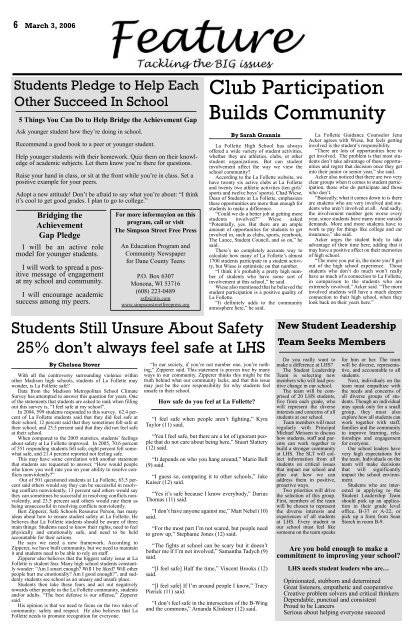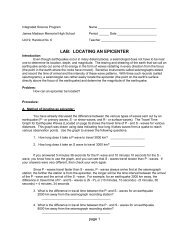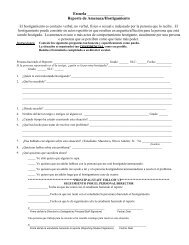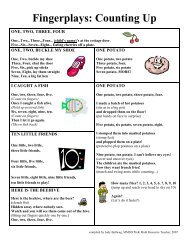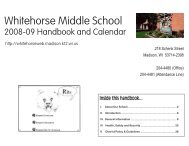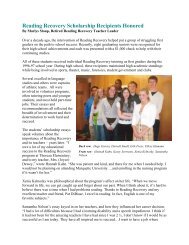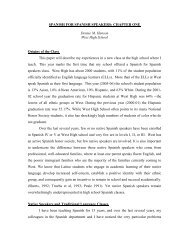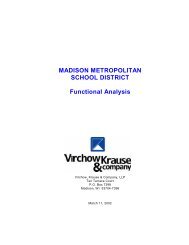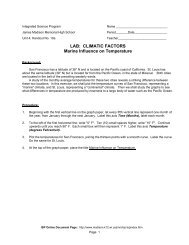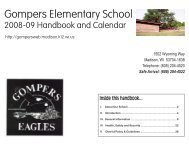March 2006 - Malcolm Shabazz City High School, Madison WI
March 2006 - Malcolm Shabazz City High School, Madison WI
March 2006 - Malcolm Shabazz City High School, Madison WI
You also want an ePaper? Increase the reach of your titles
YUMPU automatically turns print PDFs into web optimized ePapers that Google loves.
6 <strong>March</strong> 3, <strong>2006</strong>Students Pledge to Help EachOther Succeed In <strong>School</strong>5 Things You Can Do to Help Bridge the Achievement GapAsk younger student how they’re doing in school.Recommend a good book to a peer or younger student.Help younger students with their homework. Quiz them on their knowledgeof academic subjects. Let them know you’re there for questions.Raise your hand in class, or sit at the front while you’re in class. Set apositive example for your peers.Adopt a new attitude! Don’t be afraid to say what you’re about: “I thinkit’s cool to get good grades. I plan to go to college.”Bridging theAchievementGap PledgeI will be an active rolemodel for younger students.I will work to spread a positivemessage of engagementat my school and community.I will encourage academicsuccess among my peers.For more informayion on thisprogram, call or visitThe Simpson Street Free PressAn Education Program andCommunity Newspaperfor Dane County TeensP.O. Box 6307Monona, <strong>WI</strong> 53716(608) 223-0489ssfp@itis.comwww.simpsonstreetfreepress.orgClub ParticipationBuilds CommunityBy Sarah GrannisLa Follette <strong>High</strong> <strong>School</strong> has alwaysoffered a wide variety of student activities,whether they are athletics, clubs, or otherstudent organizations. But can studentinvolvement affect the way we view theschool community?According to the La Follette website, wehave twenty six active clubs at La Folletteand twenty two athletic activities (ten girls’sports and twelve boys’ sports). Chad Wiese,Dean of Students at La Follette, emphasizesthese opportunities are more than enough forstudents to make a difference.“Could we do a better job at getting morestudents involved?” Wiese asked“Potentially, yes. But there are an ampleamount of opportunities for students to getinvolved in, such as clubs, sports, yearbook,The Lance, Student Council, and so on,” hesaid.There’s no completely accurate way tocalculate how many of La Follette’s almost1700 students participate in a student activity,but Wiese is optimistic on that number.“I think it’s probably a pretty high numberof students who have some sort ofinvolvement at this school,” he said.Wiese also mentioned that he believed thestudent participation is a positive quality ofLa Follette.“It definitely adds to the communityatmosphere here,” he said.La Follette Guidance Counselor JenaAcker agrees with Wiese, but feels gettinginvolved is the student’s responsibility.“There are lots of opportunities here toget involved. The problem is that most studentsdon’t take advantage of these opportunitiesand regret that decision once they getinto their junior or senior year,” she said.Acker also noticed that there are two veryclear groups when it comes to student participation,those who do participate and thosewho don’t.“Basically, what it comes down to is thereare students who are very involved and studentswho aren’t involved at all. And sadly,the involvement number gets worse everyyear, since students have many more outsidedemands. More and more students have towork to pay for things like college and carinsurance,” she said.Acker urges the student body to takeadvantage of their time here, adding that itmay have a positive affect on their memoriesof high school.“The more you put in, the more you’ll getout of the high school experience. Thosestudents who don’t do much won’t reallyhave as much of a connection to La Follette,in comparison to the students who areextremely involved,” Acker said. “The moreinvolved students will have a much deeperconnection to their high school, when theylook back on their years here.”Students Still Unsure About Safety25% don’t always feel safe at LHSBy Chelsea StoverWith all the controversy surrounding violence withinother <strong>Madison</strong> high schools, students of La Follette maywonder, is La Follette safe?Data from the <strong>Madison</strong> Metropolitan <strong>School</strong> ClimateSurvey has attempted to answer this question for years. Oneof the statements that students are asked to rank when fillingout this survey is, “I feel safe at my school”.In 2004, 599 students responded to this survey. 62.4 percentof La Follette students said that they did feel safe attheir school, 12 percent said that they sometimes felt safe attheir school, and 25.5 percent said that they did not feel safeat their school.When compared to the 2005 statistics, students’ feelingsabout safety at La Follette improved. In 2005, 70.6 percentof 551 responding students felt safe, eight percent felt somewhatsafe, and 21.4 percent reported not feeling safe.This may have some correlation with another statementthat students are requested to answer, “How would peoplewho know you well rate you on your ability to resolve conflictsnonviolently?”Out of 501 questioned students at La Follette, 63.5 percentsaid others would say they can be successful in resolvingconflicts nonviolently, 13 percent said others would saythey can sometimes be successful in resolving conflicts nonviolently,and 23.5 percent said others would rate them asbeing unsuccessful in resolving conflicts nonviolently.Bert Zipperer, Safe <strong>School</strong>s Resource Person, has manyideas about how to ensure student safety at La Follette. Hebelieves that La Follette students should be aware of threemain things: Students need to know their rights, need to feelphysically and emotionally safe, and need to be heldaccountable for their actions.He says we need a new framework. According toZipperer, we have built community, but we need to maintainit and students need to be able to rely on staff.Zipperer also believes that the biggest safety issue at LaFollette is student fear. Many high school students constantlywonder: “Am I smart enough? Will I be liked? Will otherpeople hurt me emotionally? Am I good enough?”, and suddenlystudents see school as an uneasy and unsafe place.Students then take these fears and act out negativelytowards other people in the La Follette community, studentsand/or adults. “The best defense is our offense,” Zipperersaid.His opinion is that we need to focus on the two rules ofcommunity: safety and respect. He also believes that LaFollette needs to promote recognition for everyone.“In our society, if you’re not number one, you’re nothing,”Zipperer said. This statement is proven true by manyways in our community. Zipperer thinks this might be thetruth behind what our community lacks, and that this issuemay just be the core responsibility for why students feelunsafe in their school.How safe do you feel at La Follette?“I feel safe when people aren’t fighting,” KyraTaylor (11) said.“Yea I feel safe, but there are a lot of ignorant peoplethat do not care about being here,” Stuart Slattery(12) said.“It depends on who you hang around,” Mario Bell(9) said.“I guess so, comparing it to other schools,” JakeKaiser (12) said.“Yes it’s safe because I know everybody,” DariusThomas (11) said.“I don’t have anyone against me,” Matt Nebel (10)said.“For the most part I’m not scared, but people needto grow up,” Stephanie Jones (12) said.“The fights at school can be scary but it doesn’tbother me if I’m not involved,” Samantha Tadych (9)said.“[I feel safe] Half the time,” Vincent Brooks (12)said.“[I feel safe] If I’m around people I know,” TracyPierick (11) said.“I don’t feel safe in the intersection of the B-Wingand the commons,” Amanda Klinkner (12) said.New Student LeadershipTeam Seeks MembersDo you really want tomake a difference at LHS?The Student LeadershipTeam is selecting newmembers who will lead positivechange in our school.The team will be comprisedof 20 LHS students,five from each grade, whowill represent the diverseinterests and concerns of allstudents at our school.Team members will meetregularly with PrincipalMichael Meissen to discusshow students, staff and parentscan work together tobuild a stronger communityat LHS. The SLT will collectinformation from allstudents on critical issuesthat impact our school andplan out how we canaddress them in positive,proactive ways.Two priorities will drivethe selection of this group.First, members of the teamwill be chosen to representthe diverse interests andexperiences of all studentsat LHS. Every student inour school must feel likesomeone on the team speaksfor him or her. The teamwill be diverse, representative,and accountable to allstudents.Next, individuals on theteam must empathize withthe needs and concerns ofall diverse groups of students.Though an individualmay speak only for a smallgroup, they must alsoexplore how all students canwork together with staff,families and the communityto improve learning, relationshipsand engagementfor everyone.Our school leaders havevery high expectations forthe team. Individuals on theteam will make decisionsthat will significantlyimpact the school environment.Students who are interestedin applying to theStudent Leadership Teamshould pick up an applicationin their grade leveloffice, B-37 or A-22, orpick up a form from SeanStorch in room B-9.Are you bold enough to make acommitment to improving your school?LHS needs student leaders who are…Opinionated, stubborn and determinedGreat listeners, empathetic and cooperativeCreative problem solvers and critical thinkersDependable, punctual and consistentProud to be LancersSerious about helping everyone succeed


